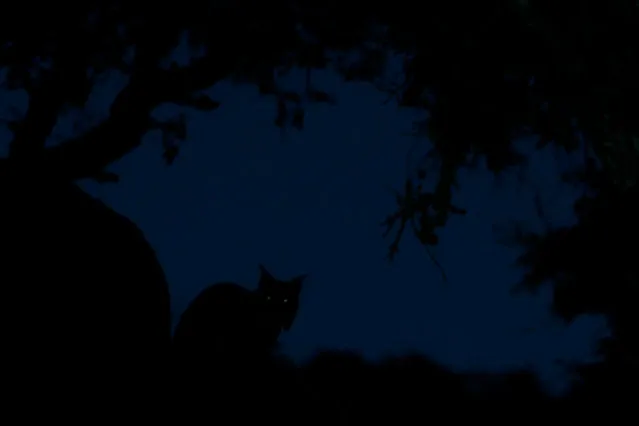
Overall winner: The Ghost – Eduardo Blanco Mendizabal (Spain). “Early this year I visited the nature park of Sierra de Andújar in Andalusia to look for the most endangered species of wild cats in Europe, the Iberian lynx ( Lynx pardinus). One evening I discovered a lynx right beside the road. The animal hardly took any notice but proceeded to groom itself quietly. Even the headlights of my car did not bother it. I took many photographs, but only in this one shot the lynx’s eyes light up ghostlike”. (Photo by Eduardo Blanco Mendizabal/2019 GDT European Wildlife Photographer of the Year)
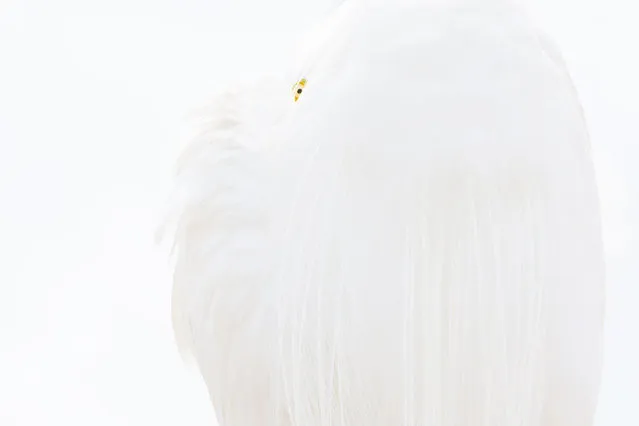
Winner, birds: Great white egret – Dr Siegmar Bergfeld (Germany). “After a wonderful photo tour in the morning, we enjoyed a bicycle trip to the marshlands near the visitor centre of Shark Valley (Everglades, Florida). On our return, the centre is full of people looking to take a ride on one of the trams through the area. Nobody takes any notice of the great white egret grooming itself extensively on the tram’s roof. I hurry to get my camera. A white cloud in the background makes it a perfect high-key portrait”. (Photo by Dr Siegmar Bergfeld/2019 GDT European Wildlife Photographer of the Year)
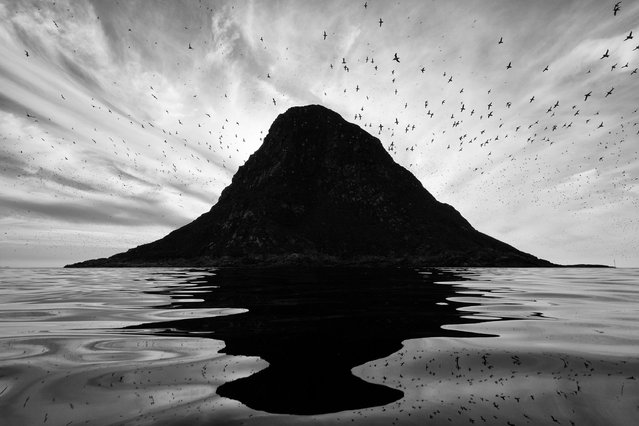
Runner-up, birds: Reflection of a bird cliff – Espen Bergersen (Norway). “This is the bird cliff of Bleiksøy, near Andøya in north Norway. It is the breeding ground of thousands of puffins and many other bird species, and sometimes large flocks of them circle the island – a stunning view. This image was taken on a still day when the cliff and the birds were reflected in the unruffled water in total perfection. A light swell kept changing the reflection, and I took a series of photographs, of which this one turned out to be my favourite”. (Photo by Espen Bergersen/2019 GDT European Wildlife Photographer of the Year)
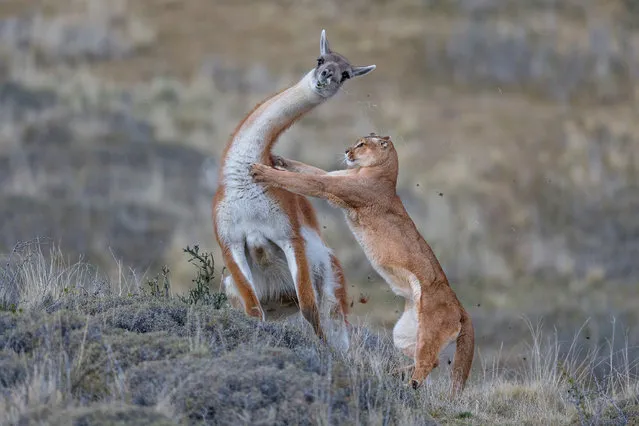
Winner, mammals: A puma hunting a fully grown male guanaco – Ingo Arndt (Germany). “To do this first complete photo reportage on pumas or cougars ( Puma concolor), I spent more than seven months in the wilderness of Patagonia. It’s been my most demanding project ever. Despite extreme wind speeds and freezing temperatures, I often lay in wait hidden behind rocks for hours or walked up to 20km. This resulted in photos of behavioural patterns never documented before. The most important image of my puma project was this one of a guanaco hunt”. (Photo by Ingo Arndt/2019 GDT European Wildlife Photographer of the Year)
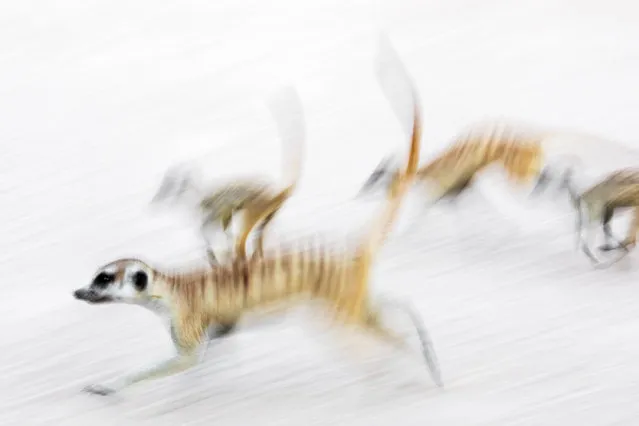
Runner-up, mammals: Meerkats on the move – Ann Toon (UK). “The image shows members of a small mob of meerkats ( Suricata suricatta) dashing across the sand in the Kgalagadi Transfrontier park, on the South African side of the reserve. They are headed to their sleeping quarters to spend the night underground safe from the Kalahari’s predators. I had been shadowing this colony for several days, photographing their behaviour. They were always on the move while at the same time keeping the tight social bond of the group. Here, I used a slow shutter speed to convey this behaviour”. (Photo by Ann Toon/2019 GDT European Wildlife Photographer of the Year)

Highly commended, mammals: Gelada after the storm – Marco Gaiotti (Italy). “Gelada baboons are the only monkey species in the world that feed on grasses. They are native to the tableland of Ethiopia. Every morning large family groups wander from their sleeping places in the steep rock face, up to 1,000 metres high, to the feeding grounds at the tablelands. This image clearly depicts their feeding strategy: they pull out bunches of grass, sort the stalks and then lift them to their mouth. This shot was taken towards the end of the rainy season after a heavy storm”. (Photo by Marco Gaiotti/2019 GDT European Wildlife Photographer of the Year)
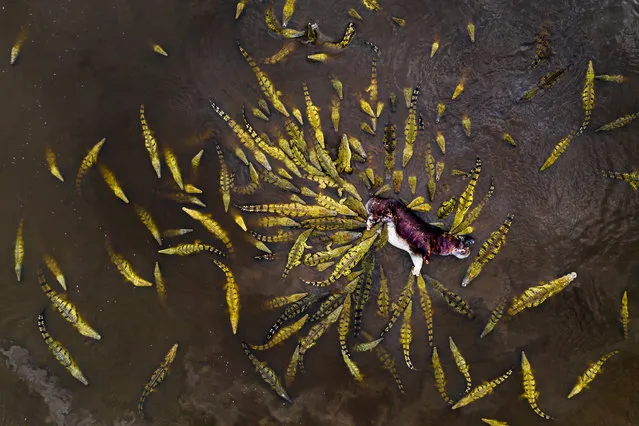
Winner, other animals: 101 crocodiles – Ignacio Medem Seghers (Italy). “The carcass of this hippopotamus, which presumably died of a natural cause, would not be there for long. After only three days, there was nothing left of the massive body, and the many crocodiles had also disappeared. This photo originates from the Luangwa River, a tributary of the Zambesi River. The title results from my attempt to count the crocodiles in this section of the picture. I did not come up with an exact number, but in any case there are more than 100 individuals”. (Photo by Ignacio Medem Seghers/2019 GDT European Wildlife Photographer of the Year)
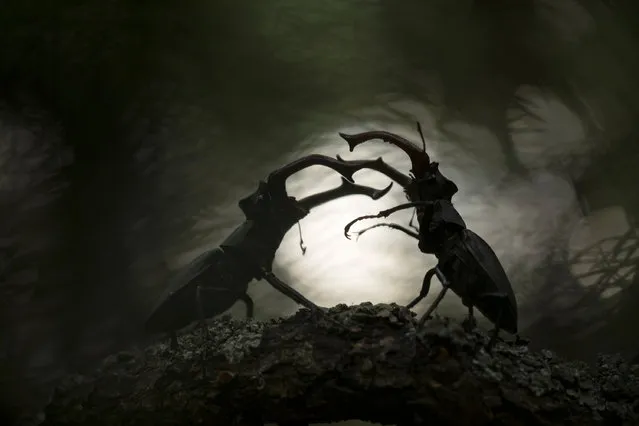
Runner-up, other animals: Battle of the titans – Svetlana Ivanenko (Russia). “The stag beetle ( Lucanus cervus) is certainly the most famous species in the family of Lucanidae. For some weeks in June their behaviour is extremely interesting. It is when the males have to stand their ground in the fight for females. This spectacle happens in old oak forests only. This photo was taken in the Voronezh region of Russia. I visit the same spot every year to delight in the behaviour of these fascinating animals. Dozens of insects compete, the females follow the proceedings and then make their choice”. (Photo by Svetlana Ivanenko/2019 GDT European Wildlife Photographer of the Year)
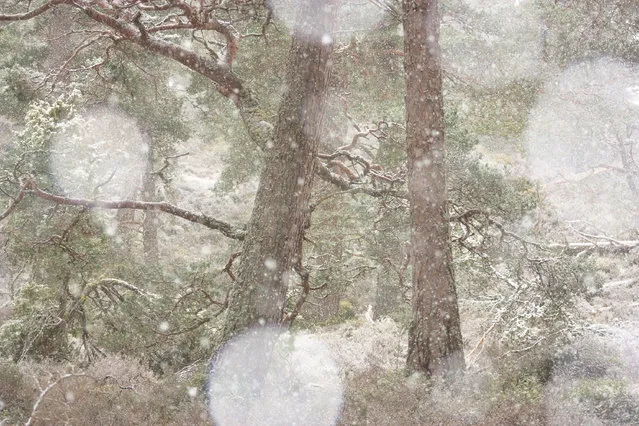
Winner, plants and fungi: Sturdy – Dorin Bofan (Romania). “The Invereshie and Inshriach nature reserve lies at the foot of the Cairngorm plateau in the Scottish Highlands. I spent a week there to photograph Scots pines ( Pinus sylvestris). Walking between the direct descendants of the original forest, some of which are several hundred years old, was a special experience for which I am very grateful. And I was even more grateful for the sudden weather changes during my stay. This photo was taken during one of several heavy snowstorms during the one week I was there”. (Photo by Dorin Bofan/2019 GDT European Wildlife Photographer of the Year)
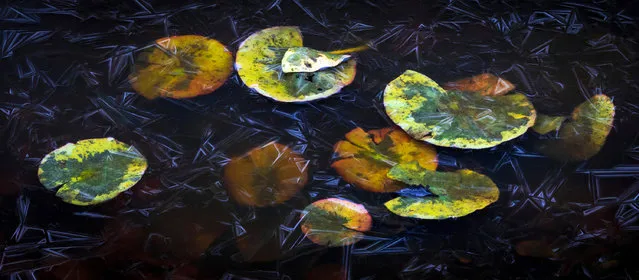
Runner-up, plants and fungi: Winter is here – Marijn Heuts (Netherlands). “After the first cold night of the winter of 2018-19, I spent the following day at Beegder heath, a small nature reserve not far from where I live. A strong wind had created interesting patterns on the thin ice, which complemented the round shapes of the water lily leaves. I used a polariser to lend the ice a deep blue colour that made for a wonderful contrast with the warm autumn colours of the leaves”. (Photo by Marijn Heuts/2019 GDT European Wildlife Photographer of the Year)
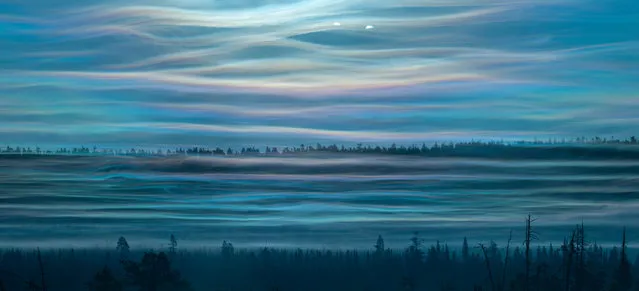
Winner, landscapes: Rainbow mist – Guillaume Bily (France). “One morning in autumn I hiked through the forest of a small Swedish nature reserve near the Arctic Circle. I was headed to a large area of raised bog. The sun was already up, there was not a breath of air, and the silence was overwhelming. When I reached the forest edge, I saw clouds of mist rising above a range of hills on the far end of the bog. They changed their shape continuously and the sun’s rays refracted on individual layers. This stunning spectacle was over after only 10 minutes and the mist dissolved”. (Photo by Guillaume Bily/2019 GDT European Wildlife Photographer of the Year)
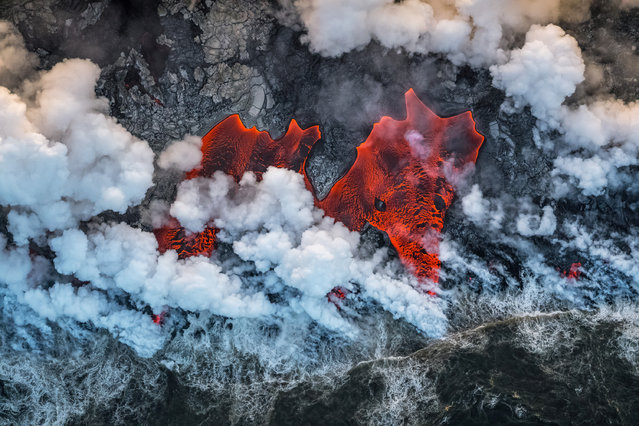
Runner-up, landscapes: The red elephant – Luis Manuel Vilariño Lopez (Spain). “May 2018 marked the beginning of the largest eruption of Kilauea volcano (Hawaii) for 200 years. The stream of lava covered a huge area, eventually reaching the ocean. I set myself the task of capturing the power and drama of these creational processes in photographs. The everchanging coast was the scene of a fierce battle between the ocean fighting for its lost space and the volcano. Clouds of acidic vapour rose above this clashing of the elements fed by giant waves the Pacific hurled up against the lava”. (Photo by Luis Manuel Vilariño Lopez/2019 GDT European Wildlife Photographer of the Year)
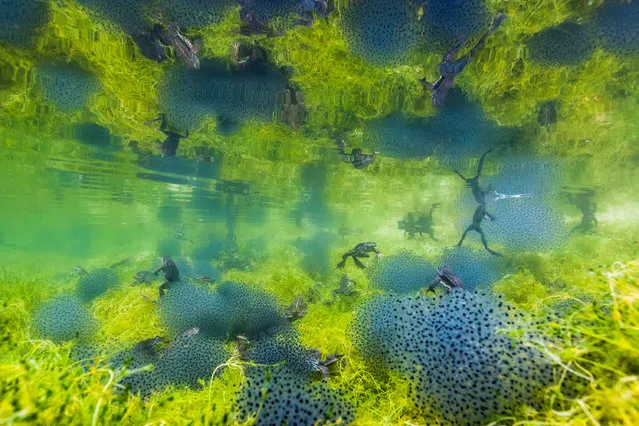
Winner, underwater world: Pond world – Manuel Plaickner (Italy). “For many years I have followed the mating season of grass frogs. As soon as the first frost-free nights with some rain are expected, they start migrating to their spawning waters. In South Tyrol there are some places where these animals gather en masse, and it is there that I can observe the spectacle. Unfortunately, their numbers are declining significantly in some of these habitats, and so I hope this photo helps to raise people’s enthusiasm for the protection of these animals”. (Photo by Manuel Plaickner/2019 GDT European Wildlife Photographer of the Year)
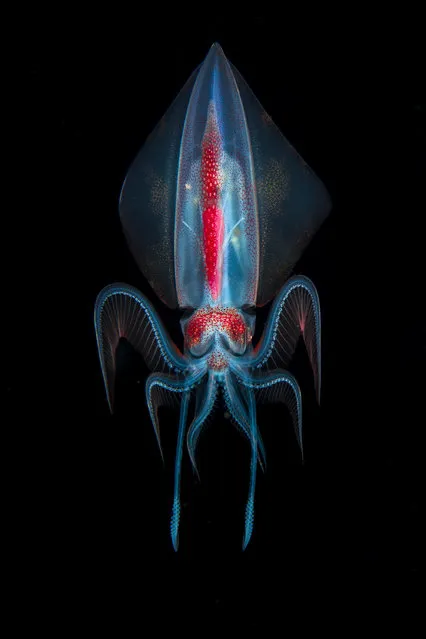
Runner-up, underwater world: Alien – Marco Steiner (Austria). “This photo shows a roughly 15cm-long diamond squid ( Thysanoteuthis rhombus) in an almost symmetrical pose. It was taken during a blackwater dive in about 15 metres depth off Kuramathi (Maldives). Blackwater dives are night dives in the open ocean with torches attached to ropes and buoys to attract plankton. Plankton migrates vertically in open water. Actually the largest migration in the animal kingdom, it takes place every night almost unnoticed”. (Photo by Marco Steiner/2019 GDT European Wildlife Photographer of the Year)
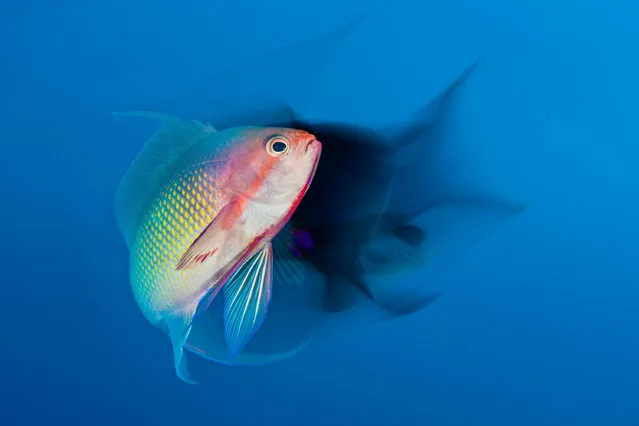
Highly commended, underwater world: Courtship dance – Alexander Mustard (UK). “Scalefin anthias (Pseudanthias squamipinnis) spawn in the evening before retreating into the reef to sleep. So I went underwater specifically in the afternoon to document the sinuous courtship dance of these animals. I used a long exposure combined with flash to reveal the moves this male uses to impress the females in his harem. This image was taken in the Red Sea at Sharm El Sheikh (Egypt)”. (Photo by Alexander Mustard/2019 GDT European Wildlife Photographer of the Year)
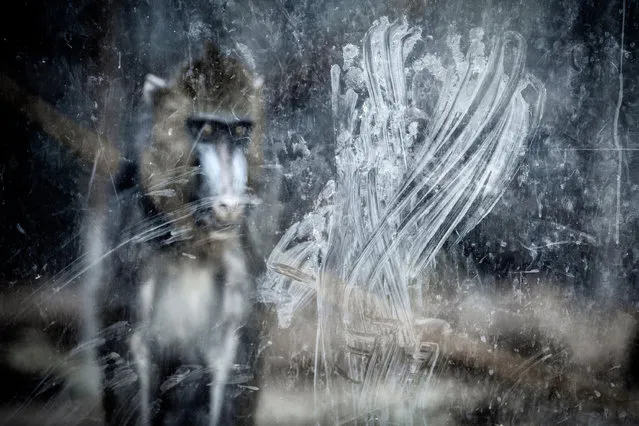
Winner, man and nature: My hands – Miguel Ángel Rubio Robles (Spain). “In the past years many zoos have tried to reinvent themselves. They justify their existence with new, roomier enclosures and a reduced number of animals. Furthermore, they place great value on keeping rare and endangered species and on developing specific breeding programmes for them. This photo shows a mandrill ( Mandrillus sphinx) at the zoo in Madrid. The glass enclosure carries the marks of his hands, a rather desperate sight”. (Photo by Miguel Ángel Rubio Robles/2019 GDT European Wildlife Photographer of the Year)
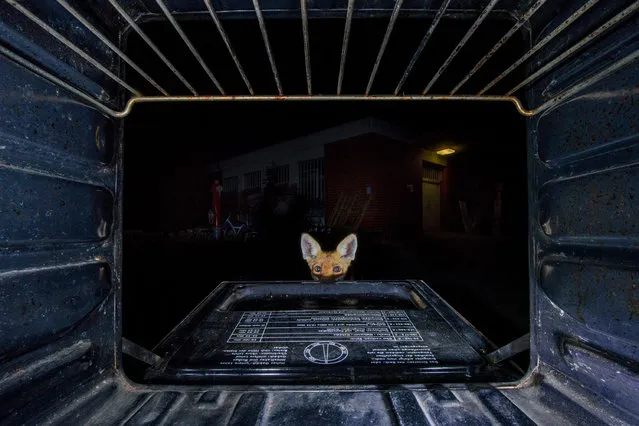
Runner-up, man and nature: What’s baking here? – Jon Andoni Juarez Garcia, (Germany/Spain). “This photo is part of the project, The Heart of the Barracks, which was developed with refugee children. The old barrack grounds, where many refugee families were housed, was a large playground for the children but also home to a lot of wild animals. For weeks and months we photographed the foxes there together, a time in which photography and these little red neighbours were a fantastic tool to help integration along”. (Photo by Jon Juarez/2019 GDT European Wildlife Photographer of the Year)
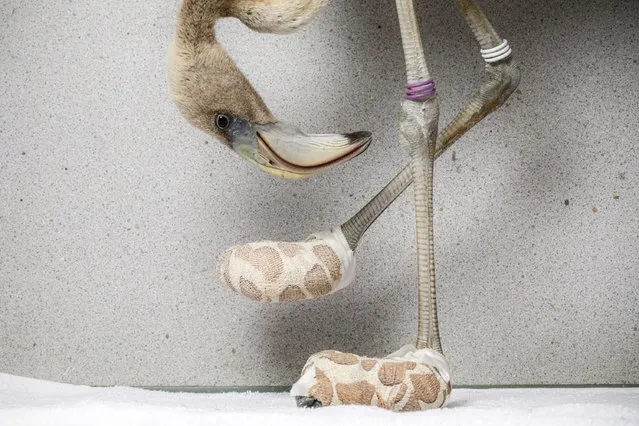
Highly commended, man and nature: Flamingo socks – Jasper Doest (Netherlands). “An American flamingo ( P hoenicopterus ruber) inspects the improvised socks that veterinarian Odette Doest has developed for its severe foot injury. Initially, the bird was brought from Bonaire to Curaçao by plane after spending some weeks at a local rehab facility. When the infection on its feet worsened, the bird sanctuary decided that the flamingo needed additional medical treatment. Dr Doest treated the bird and fashioned a pair of socks specifically fitted to the bird’s feet to speed up the healing process”. (Photo by Jasper Doest/2019 GDT European Wildlife Photographer of the Year)
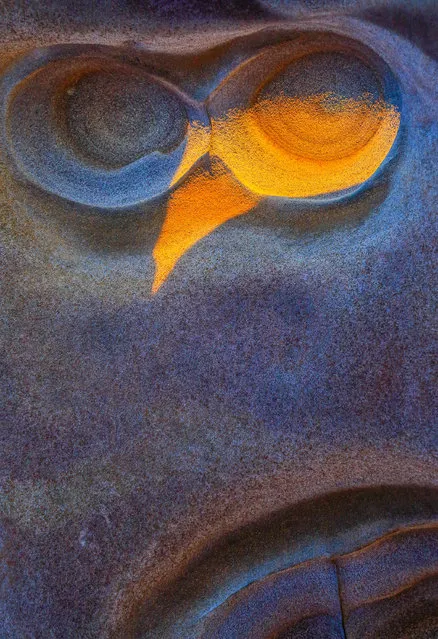
Winner, nature’s studio: Turbidite man – Fran Rubia (Spain). “This turbidite sedimentary rock consists of types of sand and marl which until 2m years ago were covered by the water of the Mediterranean Sea. It was uncovered when the land rose. I found this formation reminiscent of a human face in the Tabernas desert near Almería in Spain’s south-east. A last ray of the sun forms the nose, perfecting the illusion. This phenomenon of discovering faces or other familiar figures in patterns and structures is called pareidolia”. (Photo by Fran Rubia/2019 GDT European Wildlife Photographer of the Year)
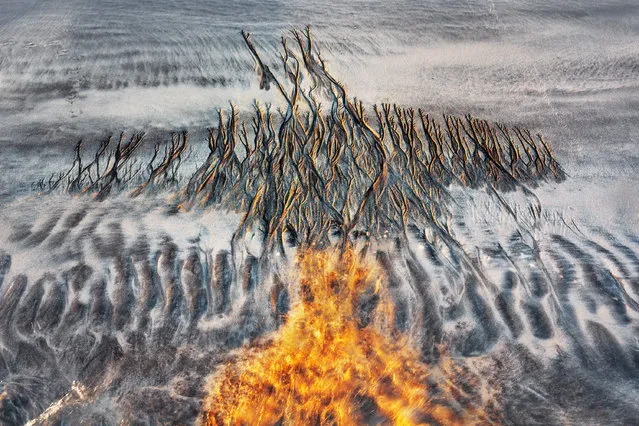
Runner-up, nature’s studio: The rebirth of Phoenix – Fortunato Gatto (Italy). “This image results not from sophisticated techniques or tricks but from a few days of contemplation which have triggered a new awareness in me. The phoenix rising from the sand is not only a texture created by the interplay of tides, above all it is a symbol of rebirth, which gave me the opportunity to see nature from a fresh perspective”. (Photo by Fortunato Gatto/2019 GDT European Wildlife Photographer of the Year)
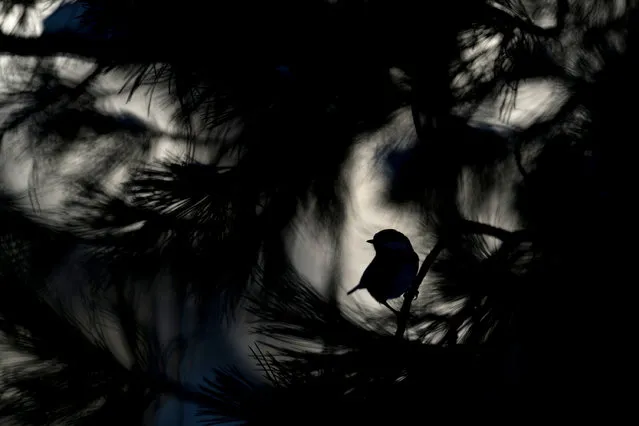
Winner, young photographers 15 to 17 years: Coal tit – Patrick Moser (Switzerland). “The coal tit ( Periparus ater) is the smallest species of tit in Switzerland and quite common in our mountain forests. This photo was taken in the middle of winter in freezing cold conditions in the Val Roseg. Although they are almost always in the shadow at this time of year, the snow-covered and sun-lit mountains in the background allow for silhouette photographs. But it takes a lot of patience to wait for a bird to sit in the right spot, and most of the time it’s long gone before the focus is right”. (Photo by Patrick Moser/2019 GDT European Wildlife Photographer of the Year)
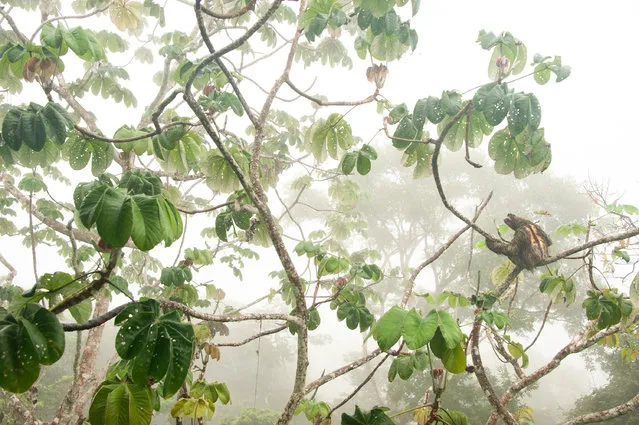
Winner, young photographers up to 14 years: In the canopy – Carlos Pérez Naval (Spain). “I photographed this Hoffmann’s three-toed sloth ( Choloepus hoffmanni) near Panama City from a visitors platform in the rainforest. It was a misty morning and the animal rested on the branches of a cecropia tree. I discovered it from the top of the visitors platform, but after I took a few shots at eye level I thought I might get a better perspective from further below. So I went down a floor to the dining room to photograph the animal with the beautiful foliage in the misty atmosphere”. (Photo by Carlos Pérez Naval/2019 GDT European Wildlife Photographer of the Year)
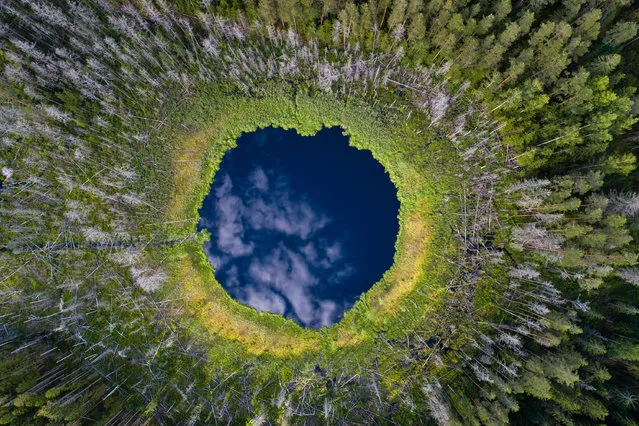
Runner-up, young photographers up to 14 years: Eye of the forest – Fred Zacek (Estonia). “This photo was taken in the south of Estonia and shows an almost round forest lake reflecting the clouds of the summer sky. I had seen a similar image in an Estonian photography competition before and urgently wanted to visit the lake myself. My father and I walked there and he allowed me to fly his drone to take this image. I was in a bit of a hurry because there was a forest full of blueberries nearby. I took the shot, handed the drone back to my father and rushed over to the berries”. (Photo by Fred Zacek/2019 GDT European Wildlife Photographer of the Year)
31 Oct 2019 00:03:00,
post received
0 comments
